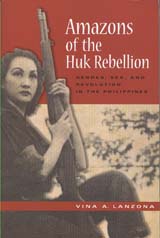-
In Amazons of the Huk Rebellion: Gender, Sex and Revolution in the Philippines, Vina A. Lanzona examines the lives of women guerillas in the Huk Movement dubbed 'Amazons' by the Philippine media. In this book, Lanzona makes a compelling argument about gender as an important facet of the Hukbalahap (Huk) Movement in the Philippines and accounts for the breakthroughs as well as drawbacks in the nationalist, radical movement committed to the liberation of women.
-
The Huk rebellion is one of the most significant peasant-based resistance movements initiated by leaders of peasant organisations and the Communist Party of the Philippines to resist the Japanese Army during World War II.[1] It became known as the Hukbo ng Bayan Laban sa Hapon (People's Anti-Japanese Liberation Army) or Hukbalahap. With the defeat of the Japanese, and with the establishment of the New Philippine Republic in 1946, the Huk's struggle took on a different form, forced to go underground by the neocolonial Philippine government, it became known as the Hukbong Mapagpalaya ng Bayan (People's Liberation Army), or HMB until its decline in the early 1960s.
-
The book consists of five chapters with catchy titles. In the introduction, Lanzona explicates her concept of gender explaining that it 'entails more than just adding the voices of women in the narratives of the revolt' (p. 9). Instead she unpacks the multiple meanings associated with femininity and masculinity, which mirrored the norms of gender relations in Philippine society. She explores the contested representations of Filipino women warriors who captured the Filipino imagination through sensationalised media coverage of women deemed 'exceptional yet anomalous' (p. 179) for possessing both masculine and feminine traits.
-
Lanzona provides colourful and poignant accounts of the lives of women guerillas as they struggled to reconcile their 'two worlds'—'the world of war and the world of love' (p. 8), battling desires for family lives with the demands of larger, collective lives as guerillas. She discusses the debates that raged as a result of women's participation in the Huk Movement.
-
Chapter one, 'Women at War' introduces women who joined the resistance movement during the Japanese occupation. This chapter offers snippets of impoverished peasant life in Central Luzon, Philippines and the political climate in the 1930s that became the hotbed for peasant rebellions. The chapter probes why and how women were roped into the Huk Movement.
-
Chapter two, 'Comrades in Arms' delves into the gender debates surrounding the role of women in post-war Philippines, encouraging women guerillas to go back to mainstream society and rebuild the respect of their families and communities by marrying and having children. Those who opted to live as guerillas became crucial in their work as couriers and linking the movement with the mass base of peasant and working-class supporters. Former Amazons reminisced about the risks experienced as couriers during the Hukbalahap and HMB. The chapter also discusses the traditional roles assigned to most women cadres who engaged in reproductive tasks within the movement and the experiences of exceptional women who emerged as leaders and military commanders in the predominantly male organisation. The chapter shows the brewing tensions surrounding the goals of the Huks, with women's motivations often reduced to familial or personal ties with men in the movement rather than ideological or political convictions. This was because women were deemed politically immature and needed the guidance and protection of their more sophisticated male comrades.
-
'Women on Top' focuses on the lives of exceptional women leaders who captured the imagination of the nation as they challenged conventional post-war images of the 'New Filipina as domestic goddess, carnival queen, social worker and homemaker' (p. 143). The chapter reveals the fascination and ambivalent reactions of the media to the captured Amazons, who were either valorised for their beauty and femininity or repudiated for their unwomanly nature and therefore undeserving of sympathy. Newspaper accounts often include stories of 'Huklings' (p. 138), or children abandoned by Huk parents, portraying Amazons as 'unnatural mothers.' The chapter shows the indelible mark left by the Amazons who paved the way for other women in revolutionary history.
-
'Love and Sex in the Time of Revolution' portrays the intimate lives of women and men in the Movement. In this chapter, we are accorded a view of the desires and frustrations of guerillas as they struggled to reconcile their intimate lives within the collective. The chapter discusses the complications of the sexual relations of women and men and their repercussions in the Huk movement. Lanzona reveals controversies that hounded the Movement in relation to the 'sex problem' (pp. 196–97), and the challenges of feminism prompting the formulation of a 'revolutionary solution to the sex problem' (p. 215) which inevitably showed the double standards imposed by the male leadership at the expense of women cadres.
-
The last chapter, 'Amazons in the Unfinished Revolution,' weaves together the issues of gender, sexuality and the family and notes the profound impact of the internal dynamics of gender relations on the outcome of the revolutionary struggle.
-
Overall, Lanzona deftly interweaves gender theory with solid data from both oral and written sources. Though at times I got lost in the stories of women, the book provides not only a veritable source of archival materials on the Huk Movement and rich biographical accounts, but adds an important dimension to the debates within the movement. I recommend this intimate, touching, poignant, insightful book as a must-read particularly for those still unconvinced that gender can be a crucial dimension of social movements and revolutions.
Endnote
[1] Vina A. Lanzona, 2009, citing Eduardo Lachica, Huk: Philippine Agrarian Society in Revolt, Manila: Solidaridad, 1971; and Alfred Saulo, Communism in the Philippines: An Introduction, Quezon City: Ateneo de Manila Univesity Press, 1990.
|



